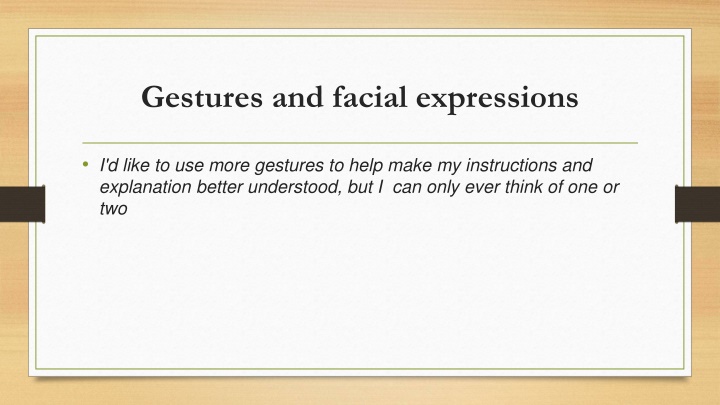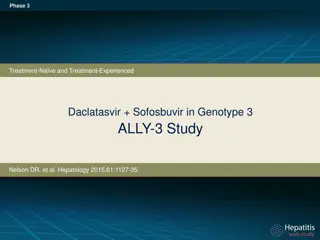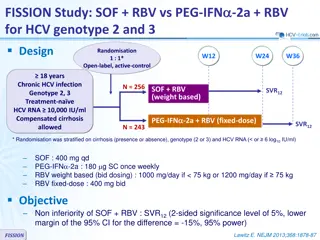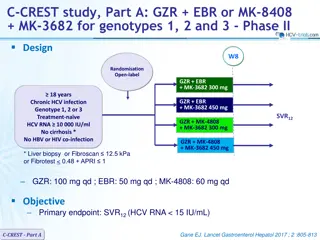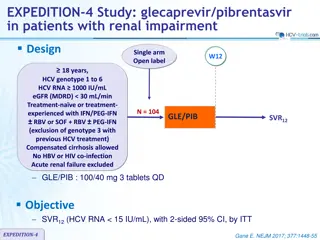Valence Study: SOF + RBV for HCV Genotypes 2 and 3
Study on the efficacy of sofosbuvir (SOF) and ribavirin (RBV) treatment in patients with chronic HCV genotypes 2 and 3, focusing on achieving sustained virological response at 12 and 24 weeks. The study included patients with treatment-naive or prior IFN-based regimen, with compensated cirrhosis allowed. Results showed high SVR rates, with multivariate analysis identifying predictors of treatment success. Detailed baseline characteristics, patient disposition, and factors associated with SVR12 were analyzed. Resistance testing was performed in patients with treatment failures. Overall, the study provides valuable insights into HCV treatment outcomes in different patient subgroups.
Download Presentation

Please find below an Image/Link to download the presentation.
The content on the website is provided AS IS for your information and personal use only. It may not be sold, licensed, or shared on other websites without obtaining consent from the author.If you encounter any issues during the download, it is possible that the publisher has removed the file from their server.
You are allowed to download the files provided on this website for personal or commercial use, subject to the condition that they are used lawfully. All files are the property of their respective owners.
The content on the website is provided AS IS for your information and personal use only. It may not be sold, licensed, or shared on other websites without obtaining consent from the author.
E N D
Presentation Transcript
Gestures and facial expressions I'd like to use more gestures to help make my instructions and explanation better understood, but I can only ever think of one or two
A class burda kaldik Happy Disgust Anger Fear Surprise Sadness
With low-level classes, gestures and expressions add a crucial element to instructions and explanations. They provide visual support that helps learners to understand what is being said.
A word of warning though! Gestures and movements do not always mean the same things internationally. If you are working outside your own culture, or with students from other countries, try to learn which gestures have inappropriate or rude meanings. You can't take anything for granted; in Bulgaria and some other countries, nodding left/right means 'yes' and up/down means 'no'!
Elevator pitch You and me Numbers Increase-decrease A really big growth A little problem Big problem *so important to me *two groups *came together/compound *every things good *give money/documents *pardon me!
Western countries hand questers Knock on wood Quotes Crazy Fingers crossed Ok / nice work Peace sign/V sign Call me * rock on * come here * me * I don t know * please/ I beg you * shot me now
Gestures Classroom organization and instructions Hands apart, with palm facing in, as if to fold around the individual. Meaning work on your own.
Classroom organization and instructions Hands wide, shaping a pair. Meaning Get into pairs.
Classroom organization and instructions Hands dividing class down middle. Meaning Get into two teams.
Classroom organization and instructions Hands held out in front, palms up, pushing upwards. Meaning Stand up.
Classroom organization and instructions Hands held out in front, palms down, waggling downwards. Meaning Sit down.
Classroom organization and instructions Hand at lips, making imaginary mouth, flapping in a 'talking' manner. Meaning Speak your answers.
Classroom organization and instructions Hand holding imaginary pen midair, wiggling. Meaning Write your answers.
Classroom organization and instructions Hands held out wide in front as if to 'fold round the class, moved upwards. Meaning Everybody say together.
Classroom organization and instructions Rodin 'fist to top of head. Meaning Think.
Classroom organization and instructions Hiding paper gesture. Meaning Keep your piece of paper secret.
Classroom organization and instructions Finger held up. Meaning First you must ...
Classroom organization and instructions Two fingers held up. Meaning Secondly you must ...
Classroom organization and instructions Three fingers held up. Meaning Thirdly, you must ... (etc.)
Classroom interaction Finger at lips. Meaning Shhh!
Classroom interaction Finger zipping lips. Meaning Stop taIking.
Classroom interaction Place a hand firmly and decisively on the desk in front of a student (and make eye contact). Meaning Everyone else has stopped talking- I want YOU to as well!
Classroom interaction Hands fiat in front of body palms down. Sliding/ cutting gesture side to side. Meaning Stop work now.
Classroom interaction Cupped hand at ears. Meaning Listen to me.
Classroom interaction Cupped hand at ears and hand indicating a student. Meaning Listen to her.
Classroom interaction Hand, palm up, held out to indicate a student. Meaning Inviting a student to answer.
Classroom interaction Both hands held out and wide, palms up. Quizzical look, eyebrows raised. Meaning Does anyone have an answer?
Classroom interaction Traffic cop hand out, palm facing student or facing down. Meaning I don't want to hear from you now.
YOU MAY READ AND GET BENEFIT PAGE 61-62 FEEDBACK ON LANGUAGE AND ERRORS
EYE CONTACT One of the most important tools at your disposal is eye contact - and it's definitely one to work on improving if you find it hard. The key techniques are to:
EYE CONTACT 1. Make eye contact with students (rather than avoiding it). Don't use pieces of paper or books as a way of hiding. Try to keep in regular eye contact with people in the class, even when doing focused tasks such as writing on the board.
EYE CONTACT 2. Allow your eye contact to remain relaxed, warm and unthreatening (rather than cold or staring).
EYE CONTACT 3. Express how you feel, showing the person behind the eyes,your warmth,your changing reactions, sense of interest and enjoyment (rather than just mechanically moving the eyes).
A few suggestions You cannot make eye contact with a whole class at once, but you can make eye contact with a number of individuals in it. When you teach the whole class from the front, don't speak to 'the room in general ' or a space slightly above everyone's heads' or 'the back wall of the room.
Similarly, don't lock your gaze onto one or two individuals and stay with them all the time you talk. Try making eye contact with one student, holding it for five to ten seconds, then gently bouncing your gaze round the room to a random different person ... and so on through the time you are speaking. Make sure you catch the eye of people in different parts of the room: back, middle and front, left centre and right.
When you talk with students working in pairs or groups, try the same technique, looking at one for a while and then undramatically shifting your focus to another
When you talk with an individual, use your eye contact to show that you are 'with them' - listening and interested.
Use eye contact to indicate who you want to talk to. Sometimes this can do away with the need for a verbal instruction.
